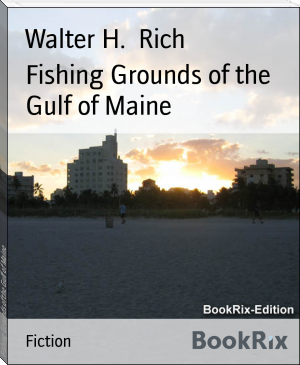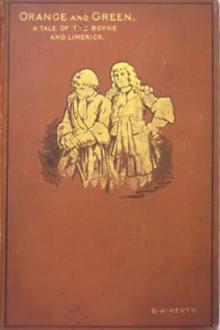Fishing Grounds of the Gulf of Maine, Walter H. Rich [readnow txt] 📗

- Author: Walter H. Rich
Book online «Fishing Grounds of the Gulf of Maine, Walter H. Rich [readnow txt] 📗». Author Walter H. Rich
Morris Ledge. This lies eastward of Chatham and is a favorite ground for certain cod fishermen during spring and early summer. Schooners and small craft operate here.
Outer Crab Ledge. The center lies about 14 miles ESE from Chatham Lights. It extends about 5 or 6 miles in a N. and S. direction and is about 1 mile wide. Depths run from 19 to 23 fathoms; the bottom is rocky. The fishing is principally for cod in the fall, winter and spring. Vessel fishing here is principally in the spring.
Nantucket Shoals. This stretch of bars and deeper waters between, roughly triangular in form with its apex at the north, lies along the western edge of the South Channel, extending S. and SE. from the southern end of Cape Cod and Nantucket Island. From Monomoy Point to Rogers Fishing Ground, on the eastern edge of Phelps Bank, it is SSE. 80 miles. Its width from Southeast Rips to the western edge of New South Shoal is 40 miles. The area includes a number of "fishing spots" and shoals, among which the following are the most important: Pollock Rip Ground, Rose and Crown Shoal, Great Rip, Davis Bank, Fishing Rip, Old and New South Shoal, and Phelps Bank.
On and about all these shoals the sail fleet makes good catches, mainly consisting of cod but with a fair proportion of pollock, also, and in the deeper water close to them, in spring and summer, a considerable amount of haddock. An occasional large halibut is taken, and even good catches have been reported. There were noted in the daily report of the Boston Fish Bureau between May 15 and August 15, 1920, 10 trips made by the smaller vessels of the halibut fleet that landed fares of from 2,000 to 10,000 pounds of this species from this area. Perhaps more would be taken if the halibut fishery were to be followed here as in other areas. "Rip fishing," as conducted here, is done "at a drift," moving over the shoals and, as they move off from them, sailing back to repeat the process. The fish are taken by hand-lining with "cockle" bait or by "jigging" the fish with a shiny piece of metal representing a herring or similar fish, below which are set twin hooks, the fish being struck when it is felt investigating the lure. This fishery generally is carried on during May, June, July, and August. In the mackerel and herring seasons these grounds usually furnish good fishing for these species, the fish usually striking here from May 15 to July 15.
Pollock Rip Grounds. These lie between Pollock Rip Lightship and Shovelful Lightship and extend northward to Pollock Rip Shoal. These grounds are 3 miles long, E. and W., by 2 miles N. and S. The depths range from 4 to 12 fathoms. These are fished from Monomoy and in stormy weather from Chatham instead of going to the Crab Ledge. Late in the spring and early in the fall the cod move inshore. In winter the cod leave Pollock Rip for the deeper water.
Rose and Crown Shoal. This is a small piece of ground 7 miles ESE. from Sankaty Head. The fishing area lies between the Round Shoal and Rose and Crown buoys, making a stretch perhaps 6 miles long by 1½ miles wide. Sometimes good fishing may be had from 6 to 12 mile, from Great Round Shoal buoy. As elsewhere on and about these shoals, the cod is the principal species caught, pollock being next in importance, and a few haddock.
Nantucket Shoals, Madisons Spot. SSE. 13 miles front Round Shoal buoy, has 9 fathoms over a smooth hard bottom of sand. It is about 3 miles long, from SE. to NW. by 1½ miles wide. This is a flounder ground for the greater part of the year and a good cod ground in October and November. As is the rule elsewhere in this neighborhood, tides are heavy over this ground.
Nantucket Shoal--Great Rip. Lies 13 miles E. by S. ½ S. from Sankaty Head Light. Nantucket. It is 5 miles long from N, to S. and 3 miles broad. Over this area the depths are from 9 to 18 feet, but the fishing is done mainly around the edges in 6 to 12 fathoms where the bottom is gravel and shells covered with sponges and kelp. Here, as on all these shoals, the greater part of the fishing is done by that method known as "rip fishing." Cod are taken chiefly by hand-lining in May. June, July, and August.
Nantucket Shoals; Davis Bank; Crab Bank. This is an irregular piece of bottom lying in a generally ENE. and WSW direction at about 20 miles distance ESE from Sankaty Head. It is perhaps 14 miles long by 5 miles wide at its broadest. Depths upon it are from 4 to 9 fathoms, with soundings of 12 to 18 about it, over a bottom of sand and broken shells.
Nantucket Shoals Fishing Rip is an elongate bank lying 29 miles SE. from Sankaty Head Light. It is 10 miles long in a NE and SW direction and Southeast Rip (Nantucket Shoals) lies SE. from Sankaty Head 35 miles. It has depths from 8 to 10 fathoms over an area about 10 miles long by 2 miles wide, with from 22 to 30 fathoms over the sandy bottom around it.
Phelps Bank. This bank lies 38 miles SE, ½ S. from Sankaty Head Light and agrees more or less in size, shape, trend, and character of the bottom with Fishing Rip. Depths are from 10 to 17 fathoms. On the southeast edge of this lies Rogers Fishing Ground, with 24 to 40 fathoms over fine gray sand. It is perhaps mainly a haddock ground.
Nantucket Shoals (South Shoal). This name is applied to the fishing ground about Nantucket Lightship, which marks the Old South Shoal and the New South Shoal, the two making a continuous reef of irregular form some 10 to 12 miles in length and from 1 to 3 miles wide. The northern end of this lies about 12 miles S. by E. from Sankaty Head (the Old South Shoal), and the southern extremity of the New South Shoal reaches to about 20 miles S. ½ E. from the same point. The fishing ground lies mostly to the S. of these shoals and about the lightship, where otter trawling is carried on in all directions from the ship except from N. to NE., where lie the vessels sunk by the German submarine in the late war. This fishery is also carried on WNW. from the ship for a distance of 40 miles, even into 7 fathom depths near Muskeget Inlet.
Elsewhere depths average from 13 to 18 fathoms on the inner parts of the grounds, whence they slope away gradually from the shore soundings into 50, 80, or even more on the outer edge, where the ground falls away rapidly into the deeps. For the most part this area has a bottom of sand, but there are small stretches of coarse gravel, broken shells, pebbles, and a few muddy spots.
Within comparatively recent years this ground has been much used by the otter trawlers, which type of craft has developed a productive fishery here, which is being operated in steadily increasing volume and takes a catch that is predominantly of haddock.
The proportion of cod taken here by these vessels is very small, even smaller than that from other grounds fished by the otter-trawl method. Pollock and hake, too, make a small item in the fares from the neighborhood of the South Shoal. In the average otter-trawl fare haddock makes up the greater part of the catch because, as a rule, this type of gear is operated mostly on the smooth, sandy bottom which this species prefers. The otter-trawl fishery here is at its best from early May through June, July, and the first halt of August. Few trips are reported from this ground at other seasons. Perhaps the haddock leaves the shoal grounds here earlier than when it moves out of the same depths in The Channel.
The early fishing for the swordfish generally takes place in this vicinity, and in normal seasons mackerel are found here in abundance from May 15 to August, and, as is the custom with this uncertain fish, it may appear here again in the late fall.
The Channel. [14] The Channel marks the western edge of Georges Bank. Its boundaries are somewhat indefinite, but the old Eldridge chart states that for the fishermen the 30 fathom curve running southerly from Race Point. Cape Cod, limits its western edge. This ground is much visited by the Boston fleet, both sail and steam, line trawlers and otter trawlers, the fleet of Gloucester, and the otter-trawl fleet that has developed in New York in recent years. This area is all good fishing ground in the proper season, but perhaps the most important is that part lying 25 miles E. ½ S. from Sankaty Head, Nantucket. Here is a level, sandy bottom, where, during May, June, July, and August, the otter trawlers operate successfully in 18 to 30 fathoms of water, making a catch that consists principally of haddock, with a considerable proportion of cod, especially in June and July, and with a fair amount also of pollock, cusk, and hake. Small halibut are fairly abundant here, also, these fish being of from 5 to R pounds, rarely larger. Flounders are abundant, with a good number of "lemon soles" and "gray soles," which are very popular with the trade.
The sail fleet operates here also, but, as a rule, more of these vessels are found on the ground lying some 10 miles farther eastward, on the edge of Georges in somewhat deeper water (30 to 50 fathoms) on a rougher and rockier bottom, where there is a greater proportion of cod in the catch than on the western area.
The Sankaty Head ground is about 20 miles long by about 8 miles wide, stretching from 55 miles SE. from Highland Light to 78 miles SE. by S ½ S. from the same point (the bottom of the Channel), and is bounded on all sides by pieces of bottom less favorable to the operation of the otter trawl because of the presence of rocks, sponges, or other obstacles, which interfere with the free passage of the net over the bottom but offer less trouble to the line-trawl fishermen. A good spring haddock ground lies ESE. 65 miles from the Highlands in 70 fathoms. best in March and April. As the cold weather advances the fish move away in great part from these grounds, going into the deeper water, the catches of the fall and winter months being taken mainly In depths of from 60 to 100 fathoms. At this season and in these depths the vicinity of the Corner of the Channel, Clarks Side. and the area N and W of the Cultivator usually have a good winter school of haddock. This has been particularly large during the past three year. (1923 to 1925). Thus, it may be seen that the Channel is an important ground during most of the year.
The figures of the catch from Clarks Bank have been shown together with those of Georges Bank. of which, in fact, this area is a part.
The larger part of the sail fleet is found fishing on the grounds of the eastern side of the Channel and of the western edge of Georges Bank, in part to escape the damage that the otter trawlers cause to them in dragging away their gear. It is often impossible for these steamers to avoid some damage of this kind: especially is this the case in the thick weather so prevalent oil Georges. In the summer months of the "mackerel years" a large catch of





Comments (0)